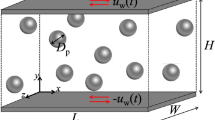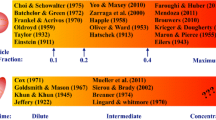Abstract
A relation is obtained to describe the effect of the volume content of particles on the effective viscosity of a concentrated monodisperse suspension of spherical particles in a medium which can be regarded as a power-law fluid. It is shown that this effect becomes weaker as the nonlinearity of the medium increases. The analysis is performed on the basis of the proposition that the deciding role is played by the lubricant action of thin interlayers of the medium between the surfaces of the particles. These results are used to calculate the viscosity of a bidisperse suspension containing a highly dispersed colloidal fraction and a coarsely dispersed fraction (filler). The viscosity is calculated as a function of the ratio of the two fractions. The calculated results are compared with experimental data for model systems.
Similar content being viewed by others
Literature cited
V. A. Ivanov, Modeling Processes in the Production and Processing of Polymers [in Russian], Sverdlovsk (1985), pp. 102–110.
G. S. Khodakov, Studies of the Technology and Equipment of the Terminal Complexes of Gas Pipelines [in Russian], Sverdlovsk (1985), pp. 102–110.
E. Godde, VDI Ber. Ver. D. Ing., No. 371, 105–110 (1980).
N. B. Ur'ev, Highly Concentrated Disperse Systems [in Russian], Moscow (1980).
N. A. Frankel and A. Acrivos, Chem. Eng. Sci.,22, 847–853 (1967).
A. L. Graham, Appl. Sci. Res.,37, 275–286 (1981).
J. Batchelor and J. Green, Hydrodynamic Interaction of Particles in Suspensions [Russian translation], Moscow (1980), pp. 11–45.
J. D. Coddard, J. non-Newtonian Fluid Mech.,2, 169–189 (1977).
L. D. Landau and E. M. Lifshitz, Hydrodynamics [in Russian], Moscow (1986).
B. V. Deryagin, N. A. Krotova, and V. P. Smilga, Adhesion of Solids [in Russian], Moscow (1973).
H. Tananka and J. White, J. non-Newtonian Fluid Mech.,7, 313–333 (1980).
G. M. Korn and T. A. Korn, A Manual of Mathematics, McGraw-Hill (1978).
V. A. Ivanov, Mekh. Kompozitn. Mater., No. 5, 940–943 (1984).
J. Happel and G. Brenner, Hydrodynamics at Low Reynolds Numbers [in Russian], Moscow (1976).
J. D. Goddard, Adv. Colloid Interface Sci.,17, Pt. B, 241–262 (1982).
E. C. Chaffey, Colloid Polym. Sci.,255, 691 (1977).
J. Mewis, Rheology. Proc. VIII Congress on Rheology. Vol. 1, 149–168 (1980).
B. V. Deryagin, N. V. Churaev, and V. M. Muller, Surface Forces [in Russian], Moscow (1985).
A. A. Potanin, N. B. Ur'ev, Ya. Mevis, and P. Moldenaers, Koiloidn. Zh.,51, No. 3, 490–499 (1989).
Author information
Authors and Affiliations
Additional information
Translated from Inzhenerno-Fizicheskii Zhurnal, Vol. 60, No. 1, pp. 32–41, January, 1991.
Rights and permissions
About this article
Cite this article
Potanin, A.A., Chernomaz, V.E., Tarakanov, V.M. et al. Flow of suspensions with a highly disperse structure-forming fraction. Journal of Engineering Physics 60, 26–33 (1991). https://doi.org/10.1007/BF00871607
Received:
Issue Date:
DOI: https://doi.org/10.1007/BF00871607




